St Eustatius is one of three northern Caribbean Dutch territories (Sint Maartin, Saba and Sint Eustatius) not far from the Virgin islands. There are three other Dutch territories (Aruba, Bonaire and Curacao) in the southern Caribbean off the coast of Venezuela. All six islands offer a mixed bag of life and sites to LGBT visitors from Europe and the Americas.
Gay Life in Sint Eustatius (Statia)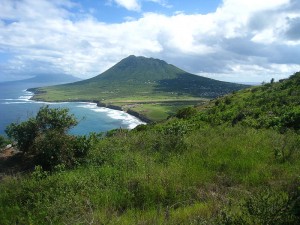
There are three quick ways to size up the ‘gay scene’ in Statia.
The first is a statement made by Commissioner of Culture Clyde van Putten who said in 2009 that there is no way the Government of St. Eustatius will implement a law allowing people of the same sex to get married. He put that position forward in a meeting with the Dutch Minister of Social Affairs Henk Kamp in the Netherlands. As of 2012, this position still holds.
The second is the line-up of conservative Christian churches on the island: Seventh Day Adventist, Methodist, Roman Catholic, Jehovah Witnesses, Bahai Faith, Baptist, Anglican, Apostolic Faith, Pentecostal and World of Faith Ministry. Except for the Bahai folks, who are liberal and very few, the others are not best friends to the LGBT community. Here, as elsewhere, politics and religion maintain discriminatory attitudes toward LGBT life. That said, there are many liberal resident individuals on Statia who respect and support gay rights but these do not form a majority.
Third, and less homophobic, is geographic: because of its steep terrain and rocky coasts Statia isn’t really a beach destination. There are only three functional beaches on the island. Oranje Beach on the western side, is calm with beige and black sand. Lynch Beach, on the Atlantic, is a small beach with shallow waters best suited for close-to-shore bathing. Zeelandia beach is a secluded strip also on the Atlantic side but has rough waters and a dangerous undertow, so is more suited to 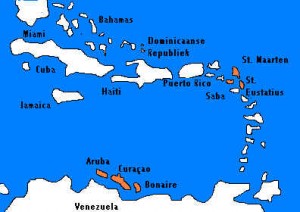 (usually non-nude) sunbathing than swimming. As well, none of the beaches are protected by lifeguards.
(usually non-nude) sunbathing than swimming. As well, none of the beaches are protected by lifeguards.
In short, there is no tourist gay scene other than what a LGBT couple or group bring with them–their selves and their private activities. Locally, most gays and lesbian natives keep a low profile since there is no group for support or social life. Doubtless, there are small circles of ‘Dorothy’s friends’ who gather for a shared meal or some gossip over coffee. People who want more gay life usually move to other more active islands such as Curacao or Puerto Rico or the mainland USA or Holland (Dutch Caribbean territorial residents are also citizens of Holland.)
For tourists, picking a hotel on Statia is fairly simple, since there are only five to choose from: The Country Inn with six rooms in a garden setting; the seaside, 20-room Golden Era Hotel; the Kings Well resort with its dozen villas and views of Oranje Bay; the 19-room Old Gin House, built of bricks carried as ship’s ballast and surrounded by tropical gardens; and the Statia Lodge, with 10 private cottages located between a dormant volcano and the Caribbean.
The same goes for eating: Statia is hardly a culinary destination like nearby St. Barths, but the island’s dozen-plus restaurants include some interesting options. Fine dining is generally limited to hotels like the Kings Well and the Old Gin House, but don’t miss the Ocean View Terrace, located in the courtyard of the Government Guest House overlooking Fort Oranje. Most restaurants are casual, and choices include burgers, pizza, local cuisine, and a surprising number of Chinese restaurants. The Smoke Alley Bar and Grill is an open-air beach bar and restaurant.
And finally, in reference to (non-gay) social life: Statia is not a party destination; the nightlife here is generally limited to hotel lounges and a handful of bars. The Smoke Alley Bar and Grille on Gallows Bay, an open-air beach bar, is probably the best bet for a classic Caribbean experience. Local bands also typically play at bars in downtown Oranjestad on weekends.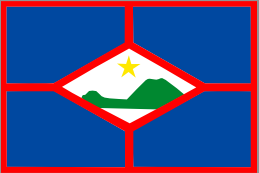 (photo right: Statia flag)
(photo right: Statia flag)
Statia Tourist Life
The island has a modern population of about 4,000 inhabitants. Its size: 8.1 square miles. The capital town is Oranjestad, pollution about 1000. Dutch, English and Spanish are spoken. It is located 33 miles south west of the coast of Dutch St. Maarten island.
The most notable landmark is the famous Quill, (top photo) which is an extinct volcano which can be climbed by hardy walkers, passing through dense forest and rain forests.
The other major appeal of Statia are the underwater sights accessed by means of scuba diving. There are haunting and picturesque old shipwreck skeletons located in only 60 to 70 feet depths, coral pinnacles and large varieties of underwater flora and fauna species in the shallow waters off the coast, which are protected by a marine park around the island. 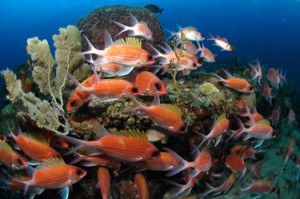 There are three dive schools on the Island with professional instructors.The seas around Statia are considered amongst the most pristine in the world, mainly due to the minimal diving pressure. The shallower reefs of 40 feet (12 m.) to 75 feet (23 m.) have been carved from volcanic fingers that are covered with a variety of soft and hard corals.
There are three dive schools on the Island with professional instructors.The seas around Statia are considered amongst the most pristine in the world, mainly due to the minimal diving pressure. The shallower reefs of 40 feet (12 m.) to 75 feet (23 m.) have been carved from volcanic fingers that are covered with a variety of soft and hard corals.
(Tourism source: http://www.coconutsdiveandadventure.com/statiahome.html)
Another curious pastime is searching for the famous ‘Blue Beads’. These are small blue glass beads that were used for trading in centuries past. Historical myths offer that these same beads, thirteen in number, were used by Peter Stuyvesant when he bought Manhattan island from the Indians. The truth is that Pete Minuit did the purchase for 60 guilders in 1626. (The island was later ceded provisionally to the English in 1664, after which it was renamed New York.) The beads can be found (rarely) near the shorelines.
If you have the time, the island comes a bit more alive for the annual (and amateurish) Carnival celebration over the span of two weeks in July and August, since 1964. The island also has a Statia-America Day, Nov. 16, recognizing the fact that St. Eustatius was the first foreign political entity ever to acknowledge the independence of the U.S. from the U.K. Other major holidays include the Dutch Queen’s Birthday (April 30), Emancipation Day (July 1), and Antillean Day (Oct. 21). Historical walking tours are also popular there.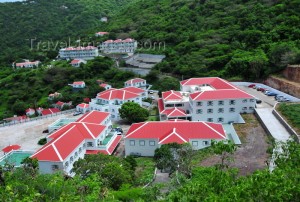
Sint Eustatius has a modern medical university with more than 100 students. (photo right) It was founded in 1999 by a group of medical school educators and administrators, and began instruction on September 1, 1999.
History
Similar to nearby Saba island the original natives date back thousand of years with the eventual brutal dominance of the Carib tribes over the Arawaks.
Columbus wrote in his 1493 diaries about seeing these islands but did not land on either one mostly due to the dangerous rocky shorelines. Originally claimed for Spain, the islands of St. Eustatius, St. Maarten and Saba eventually fell under direct command of the Dutch West India Company in 1678. This was after numerous international battles, including the invasion of the Netherlands colonies by the English Peter Stuyvesant of New York fame.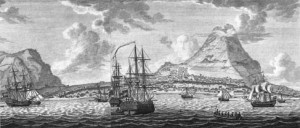
During the 17th and 18th century, Statia was a major trading center with some 20,000 inhabitants and thousands of ships calling at her shores. The Bay was lined with hundreds of warehouses packed with goods, including weapons. During the latter part of the 18th century, St. Eustatius was the major supplier of arms and ammunition to the rebellious British Colonies in North America since the island sold arms and ammunition to anyone willing to pay. It was one of the few places from which the rebellious American colonies could obtain weaponry.
For a while, Statia was the only link between Europe and fledgling American colonies. Even Benjamin Franklin had his mail routed through Statia to ensure its safe arrival. Statia remembered as the emporium of the Caribbean, was nicknamed “The Golden Rock”, reflecting its former prosperous trading days and wealthy residents.
This good relationship between St. Eustatius and the emerging United States resulted in the noted “First Salute” of 16 November 1776, when Commander Johannes de Graaff of St. Eustatius decided to return the 11-gun salute canon fire of the visiting American brig Andrew Doria. By firing the 13 c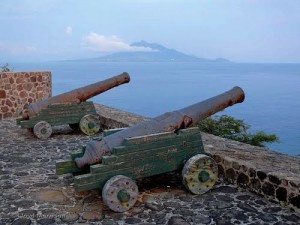 annons of Fort Oranje, de Graaff signaled the first official international recognition of the independence of the new United States.
annons of Fort Oranje, de Graaff signaled the first official international recognition of the independence of the new United States.
In 1939 while in the harbor of St. Eustatius, U.S. President Franklin Delano Roosevelt recognized the importance of the event by presenting a plaque that marked: “Here the sovereignty of the United States of America was first formally acknowledged to a national vessel by a foreign official.”
More trade (both legal and illegal) transpired here after the end of the American Revolution than on any other Caribbean island until Statia reached its economic peak around 1795. It is hard for present day visitors to imagine that this tiny island once had one of the busiest ports in the region.
As the eighteenth century drew to a close St. Eustatius gradually lost its importance as a trading center and most merchants and planters left the Island, leaving their homes and warehouses. Through the nineteenth- and early twentieth-centuries Statia became and remained a quiet island waiting to be discovered by history minded visitors. Fortunately, in the 1960’s and 70’s, the people of Statia became increasingly aware of the cultural value of their unique heritage and initiatives were taken to preserve and maintain it.
(History source: http://en.wikipedia.org/wiki/Sint_Eustatius)
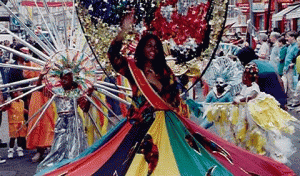 To promote the exploration and dissemination of the unique history and culture of this special island, the St. Eustatius Historical Foundation was founded. New museums are planned including preservation of the exterior structure of Honem Dalim, St. Eustatius’s Jewish Synagogue through the Historic Core Renovation project. (photo left: Statia Carnival)
To promote the exploration and dissemination of the unique history and culture of this special island, the St. Eustatius Historical Foundation was founded. New museums are planned including preservation of the exterior structure of Honem Dalim, St. Eustatius’s Jewish Synagogue through the Historic Core Renovation project. (photo left: Statia Carnival)
The island’s Statia-America Day, is based on St. Eustatius being the first foreign political entity ever to acknowledge the independence of the U.S. from the U.K. The gesture also provided the title for Barbara W. Tuchman’s 1988 book, The First Salute: A View of the American Revolution.
Complied by Richard Ammon
GlobalGayz.com
September 2012
Statia info:
http://www.statiatourism.com/
http://gocaribbean.about.com/od/othergreatislands/bb/StatiaGuide.htm
http://www.coconutsdiveandadventure.com/statiahome.html
http://en.wikipedia.org/wiki/Sint_Eustatius
















